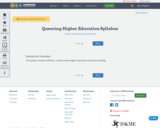
This syllabus reviews LGBTQIA+ contexts within higher education institutional settings.
- Subject:
- Gender and Sexuality Studies
- Higher Education
- Material Type:
- Syllabus
- Author:
- Sarah Simi Cohen
- Date Added:
- 11/23/2022

This syllabus reviews LGBTQIA+ contexts within higher education institutional settings.

This lesson focuses on early Asian immigrants to the United States, their reasons for immigration, successes they experienced, challenges they faced, and the changing reception they received in their host country. Students will learn what an immigrant is, what it means to be an “American, what the American Dream is, and how primary sources and secondary sources provide varied perspectives that inform a deeper understanding of an event.
2021 Social Science Standards Integrated with Ethnic Studies:
Civics and Government: K.1, 3.2, 5.1
Historical Knowledge: 2.16, 5.22
Historical Thinking: K.17, K.18, 2.22
Social Science Analysis: 1.19, 1.21, 3.18, 3.19, 4.24, 5.27

This activity encourages students to reflect on their individual cultures and histories, their backgrounds, the things they grew up with (some that may have been in their control and others that they had no choice about), and their values. In the end, students will begin to enlarge their perspective and recognize diversity of belief and background.

This lesson series introduces students to four key figures in LGBTQ history who made incredible contributions to the civil rights movement: James Baldwin, Lorraine Hansberry, Pauli Murray and Bayard Rustin.
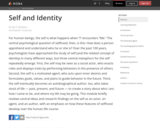
For human beings, the self is what happens when “I” encounters “Me.” The central psychological question of selfhood, then, is this: How does a person apprehend and understand who he or she is? Over the past 100 years, psychologists have approached the study of self (and the related concept of identity) in many different ways, but three central metaphors for the self repeatedly emerge. First, the self may be seen as a social actor, who enacts roles and displays traits by performing behaviors in the presence of others. Second, the self is a motivated agent, who acts upon inner desires and formulates goals, values, and plans to guide behavior in the future. Third, the self eventually becomes an autobiographical author, too, who takes stock of life — past, present, and future — to create a story about who I am, how I came to be, and where my life may be going. This module briefly reviews central ideas and research findings on the self as an actor, an agent, and an author, with an emphasis on how these features of selfhood develop over the human life course.

This lesson uses the strategies of “student questioning for purposeful learning” (SQPL) and jigsaw grouping to engage students in examining Constitutional issues related to school-based grooming policies.

This lesson will engage students in the debate about the efficacy of social media as a tool for social change.

This course explores how social theories of urban life can be related to the city’s architecture and spaces. It is grounded in classic or foundational writings about the city addressing such topics as the public realm and public space, impersonality, crowds and density, surveillance and civility, imprinting time on space, spatial justice, and the segregation of difference. The aim of the course is to generate new ideas about the city by connecting the social and the physical, using Boston as a visual laboratory. Students are required to present a term paper mediating what is read with what has been observed.
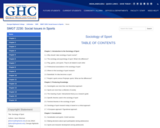
Studying sports as social phenomena helps us understand the ways that social class, gender, race and ethnicity, sexuality, and physical ability influence our everyday lives. Sports are also linked with the organization and dynamics of family life. Parents and educators see them as tools for teaching values to young people. Politicians often see them as vehicles for developing local and national identities, and corporations sponsor certain types of sports to market both products and ways of thinking about competition and consumption to people worldwide. Corporate executives now realize that sponsoring people’s pleasures (i.e., sporting events) produces support for their products. At the same time, most sports organizations seek corporate support to ensure their survival.

This lesson challenges students to analyze and to reflect on messages presented in songs — and to express their own views about important issues addressed in some songs.
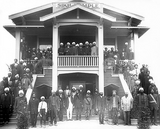
As students study the impact of immigrants and the development of the United States, regionally and as a whole, early South Asian immigration should be discussed. Early South Asian immigrants played a significant role in the nation’s economic and agricultural development, especially in California. Early South Asian immigrants formed their own communities and created unique communities with other marginalized communities around them, such as Black, Mexican, and Puerto Rican communities. This lesson focuses on the experiences and impact of these early South Asian Americans.
2021 Social Science Standards Integrated with Ethnic Studies:
Civics and Government: 5.1, 5.4, 6.4
Economics: 4.4
Historical Knowledge: 5.22, 6.20, 6.21
Historical Thinking: 5.23, 5.24, 6.23, 6.24, 6.28
Social Science Analysis: 4.21, 4.24, 5.26, 5.27

Course Sequences
Spanish IV aims at developing and improving student’s oral and written communication through the continued study of the language, literature and culture of Spain, Latin America and Hispanic communities in the United States. It also seeks to improve students’ ability to read and appreciate literary and non-literary texts in Spanish, deepening this way students’ awareness and understanding of the cultural diversity of the Spanish-speaking world. The course is organized by themes based on contemporary social, political and cultural issues of Spanish-speaking societies such as: cultural identity, the changing roles of women and family, economic development and its effects on cultural heritage and environment, and the individual’s rights in the political system.
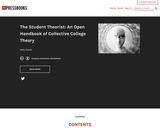
Welcome to Critical Theory! We know that this field probably seems daunting, but now that you’re here, we’re here to help you get more comfortable with concepts such as ideology, constructivism, and the uncanny, to name a few. This handbook is a student-built guide that explains and exemplifies different literary theories. Written in accessible language with modern-day examples, this handbook seeks to make literary theory more manageable.
This handbook is a blend between a traditional textbook and an experimental anthology. It includes a range of pieces that show students grappling with the concepts themselves. Moreover, it’s free and organized according to the theories presented in the syllabus.

This course explores the diverse ways that people teach and learn—in different countries, in different disciplines, and in different subcultures. We will discuss how theories of learning can be applied to a variety of hands-on, in-class learning activities. We compare schooling to other forms of knowledge transmission from initiation and apprenticeship to recent innovations in online education such as MOOCs. Students will employ a range of qualitative methods in conducting original research on topics of their choice.

This course centers on the changing relationships between men, women, and technology in American history. Topics include theories of gender, technologies of production and consumption, the gendering of public and private space, men’s and women’s roles in science and technology, the effects of industrialization on sexual divisions of labor, gender and identity at home and at work.

Aim is to analyze important current events for what they reveal about the nature and working of our technological world. Starting point is connection between technology and terrorism. Subject also explores how a human-built world can foster insecurity and danger, and how human beings respond. Many invited guests help develop a strong interdisciplinary approach (science, engineering, social science, humanities). Topics include technological risk and remediation, sociotechnical systems, imagination of disaster, technology and identity, technology and religion, technology and education, and technology and trust. Written and oral assignments and a final project required. Service-learning proposals and web-based presentations, in addition to written work, may be considered for the final project by the instructor.
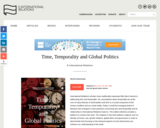
International Relations scholars have traditionally expressed little direct interest in addressing time and temporality. Yet, assumptions about temporality are at the core of many theories of world politics and time is a crucial component of the human condition and our social reality. Today, a small but emerging strand of literature has emerged to meet questions concerning time and temporality and its relationship to International Relations head on. This edited collection provides a platform to continue this work. The chapters in this book address subjects such as identity, terrorism, war, gender relations, global ethics and governance in order to demonstrate how focusing on the temporal aspects of such phenomena can enhance our understanding of the world.

This textbook presents core concepts common to introductory social psychology courses. The 8 units include 27 modules covering key social psych topics such as research methods, group processes, social influence, and relationships. This book can be modified: feel free to add or remove modules to better suit your specific needs. The book includes a comprehensive instructor's manual, PowerPoint presentations, a test bank, reading anticipation guides, and adaptive student quizzes.

This course considers reggae, or Jamaican popular music more generally—in its various forms (ska, rocksteady, roots, dancehall)—as constituted by international movements and exchanges and as a product that circulates globally in complex ways. By reading across the reggae literature, as well as considering reggae texts themselves (songs, films, videos, and images), students will scrutinize the different interpretations of reggae’s significance and the implications of different interpretations of the story of Jamaica and its music. Beginning with a consideration of how Jamaica’s popular music industry emerged out of transnational exchanges, the course will proceed to focus on reggae’s circulation outside of Jamaica via diasporic networks and commercial mediascapes. Among other sites, we will consider reggae’s resonance and impact elsewhere in the Anglo Caribbean (e.g., Trinidad, Barbados), the United Kingdom (including British reggae styles but also such progeny as jungle, grime, and dubstep), the United States (both as reggae per se and in hip-hop), Panama and Puerto Rico and other Latin American locales (e.g., Brazil), Japan and Australia, as well as West, South, and East Africa (Côte d’Ivoire, Tanzania, Uganda).

How are migrants portrayed in the news and media? Who gets to tell the story of migration, and what aspects of the story tend to go underreported? How do these stories, and the perspectives from which they’re told, impact our own perceptions of migration?
In this unit, students learn to identify underreported stories of migration, and what is missing from mainstream media representations of migrants’ experiences. They analyze nonfiction texts and images, practice identifying perspectives in media, and synthesize their learning to form a new understanding of migration. In their final project, students communicate how their perspective on migration has grown or changed through a creative project, original news story, or existing news story edited to provide a more holistic picture of migration.